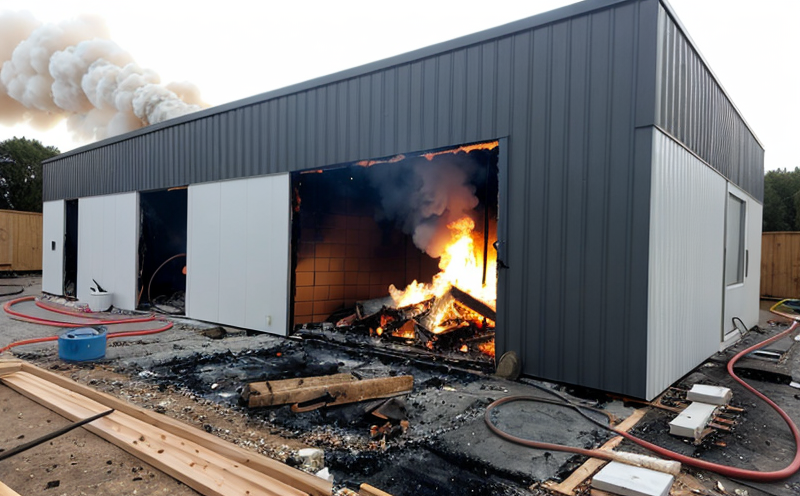ASTM E84 Surface Burning Characteristics of Building Materials Validation Method Development Test
The ASTM E84 standard is a widely recognized method used to assess the surface burning characteristics of building materials. This test evaluates the flame spread and smoke production of materials when exposed to an ignition source. The results are classified into one of three categories: Class A, B, or C, with Class A being the highest rating for fire resistance.
Developing a validation method for ASTM E84 involves ensuring that the test parameters are strictly followed, using appropriate materials and equipment to produce consistent and reliable data. The testing process begins by preparing specimens according to the specified dimensions in the standard. Specimens are then placed on a standardized bench, where they are exposed to a flame source for a set duration.
The flame is typically applied from one end of the specimen, and the time it takes for the fire to spread along its length is measured as an indicator of flame spread. Smoke production is also quantified by measuring the amount of smoke generated during the test. This data is crucial for understanding the material's behavior under fire conditions.
Validation involves comparing the results from different laboratories using identical specimens and methods, ensuring that the results are consistent and reproducible. This process helps to establish confidence in the accuracy and reliability of the ASTM E84 testing method. The validation can be conducted by multiple labs across various regions or under specific conditions to ensure robustness.
Developing a test method requires careful consideration of all factors that could influence the outcome, including environmental conditions such as temperature and humidity, material properties like thickness and density, and ignition source characteristics. By understanding these variables, researchers can refine the testing protocol to minimize variability in results.
The importance of ASTM E84 validation cannot be overstated, especially for materials used in high-risk environments like hospitals, schools, and other public buildings. Ensuring that building products meet or exceed the required fire resistance standards is critical for protecting lives and property. By validating the test method, we ensure that the results are accurate and can be trusted by all stakeholders involved.
Validation also plays a crucial role in research and development (R&D) efforts aimed at improving material performance. Engineers can use validated ASTM E84 data to identify areas for improvement and develop new materials with enhanced fire safety properties. This iterative process helps drive innovation in the building products sector, leading to safer and more effective solutions.
Furthermore, validation ensures that procurement decisions are based on reliable information. When specifying materials for a project, architects and contractors can rely on validated ASTM E84 results to make informed choices that meet safety requirements. This not only enhances project quality but also contributes to overall fire safety in the built environment.
Why It Matters
The importance of ASTM E84 validation cannot be overstated, especially for materials used in high-risk environments like hospitals, schools, and other public buildings. Ensuring that building products meet or exceed the required fire resistance standards is critical for protecting lives and property.
Fire safety is a key concern in construction due to the potential risks associated with poorly designed or constructed buildings. The ASTM E84 test provides valuable insights into how materials behave under fire conditions, helping to identify those that offer superior protection against flames and smoke. This information is essential for designing safer structures and selecting appropriate materials during procurement.
Compliance with fire safety regulations is mandatory in many countries, making it imperative for manufacturers and builders to understand the requirements and adhere to them rigorously. ASTM E84 validation ensures that products meet these standards, thereby facilitating compliance and reducing liability risks associated with non-compliant materials.
In addition to enhancing safety, ASTM E84 validation supports sustainable building practices by promoting the use of fire-resistant materials that contribute positively to energy efficiency and indoor air quality. By selecting materials based on validated test results, builders can create healthier environments that support long-term occupancy and well-being.
Benefits
- Enhanced Safety: ASTM E84 validation ensures that building materials meet strict fire resistance standards, enhancing overall safety in public spaces.
- Compliance Assurance: By adhering to validated ASTM E84 test methods, manufacturers and builders can ensure compliance with international regulations.
- Informed Decision-Making: Validated results provide reliable data for architects, engineers, and contractors to make informed choices about materials.
- Risk Reduction: Using validated ASTM E84 test methods helps reduce liability risks associated with non-compliant products.
- Sustainable Practices: Fire-resistant materials contribute positively to energy efficiency and indoor air quality, supporting sustainable building practices.
- Innovation Support: Validated data enables researchers to refine material properties and develop new fire-safe solutions.
Environmental and Sustainability Contributions
The ASTM E84 test method plays a significant role in promoting sustainable building practices by encouraging the use of materials that enhance both safety and environmental performance. Fire-resistant materials contribute to energy efficiency, as they help maintain optimal indoor temperatures without excessive heat transfer through walls or ceilings.
Additionally, fire-safe buildings are often designed with better ventilation systems, which improve air quality inside the structure. This leads to healthier living and working environments, supporting occupant well-being. By selecting materials based on validated ASTM E84 test results, builders can contribute to a more sustainable future by minimizing environmental impact while ensuring high levels of safety.
The use of fire-resistant insulation and cladding systems is particularly beneficial in modern buildings, where the goal is often to achieve LEED certification or other green building standards. These materials not only provide excellent thermal performance but also help reduce carbon emissions associated with heating and cooling.





